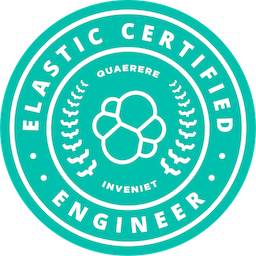Description here
Update: July 2020: I am now building lab exercises to help people prepare for the exam. You can see the list of available labs here
I passed my exam to become an Elastic Certified Engineer in July 2019 and I thought I would share my experience of the process and answer a few common questions.
Certification Overview
The certification is more involved than others. There are no multiple choice questions - it’s all lab exercises; reindexing data, running searches and aggregations, creating ingest pipelines, configuring hot/warm architecture, etc. You’ll provide the JSON you used for the task, or the state of the cluster will be tested after the exam to grade you.
I feel this gives the certification some weight. It’s not a simple memory exercise where being able to recall the reference will win you a badge. You have to be able to interpret what the question is asking, figure out how to implement what’s required, then do so in short order.
You can find a lot more information by having a look over Elastic’s official page describing (selling) the certification. They also have a great video about what is involved, which I cannot recommend enough as it will reduce the number of surprises when you attempt the exam.
Motiviation
I went through the process primarily to cement what I had learned on the Elastic Engineer I & II courses. It’s one thing to go through a course and another to be able to be able to correctly implement what you learned.
Preparation
The most important piece to read is the exam objectives. Simply put, if you can do everything listed, you’ll be well prepared. I went through the labs from the two courses I attended several times until I could complete them without refering to the documentation.
Practice, practice, and practice some more. The more familiar you are with the various APIs, the better. You’ll only have access to the Elastic documentation; as you take the exam in a virtual environment, the rest of the internet is unavailable. Learn to use the Elastic documentation site; the content is great but finding things can be difficult and it helps if you know where to look.
You can configure a reasonable cluster on a medium-spec laptop by using Vagrant and VirtualBox to provision a few virtual machines for you. I will do a post on how I configured this because it will get you to a remarkably similar environment to the one you’ll be using in the exam. Set up a three node cluster and ingest some data. Then you’ll be in a good position to practice searches, aggregations, shard allocation, shard filtering, taking and restoring snapshots, configuring hot/warm architecture, and so on.
The day
I booked my exam for 1PM so I would have some time in the morning to go over my notes and get fully prepared in plenty of time.
I heeded the advice in the video about reading all the questions first and attempting the easier ones to build some momentum, which helped enormously.
Out of the 11 questions, I answered 10 with an hour to spare so had plenty of time to answer the one I saved for last. I had to write a custom analyser but read the question too literally and wasted a good 30 minutes on a dead end. Once I figured out I was doing it completely wrong, I had it working 5 minutes later.
After checking my answers again, I was done with about 10 minutes left on the clock. Quite the emotional journey!
Results day
It took a few days to hear back and it was a huge relief to find out I passed. I was emailed a link to a badge, and invited to a LinkedIn group to discuss Elasticsearch with other certified professionals.
A few weeks later, I received a physical ‘coin’ that now adorns the bookshelf in our living room, much to my wife’s ‘delight’.
Afterword
Was it worth it? Time will tell.
It gave me the confidence boost I was chasing and encouraged me to get deeper into the Elastic Stack.
Since the exam, I’ve written a custom Beat in Go, developed a Logstash pipeline for data enrichment, and begun ingesting some datasets to gain more experience with different types of data.
Like most software, the Elastic Stack is constantly evolving and staying on top of things requires a high degree of continual learning. This can become exhausting but it’s an important skill to have if you work in the industry.
If you decided to have a go at the certification, I wish you the best of luck. It’s a great programme; well organised, and challenging but fair.
